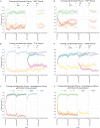Ambiguity drives higher-order Pavlovian learning
- PMID: 36084131
- PMCID: PMC9491594
- DOI: 10.1371/journal.pcbi.1010410
Ambiguity drives higher-order Pavlovian learning
Abstract
In the natural world, stimulus-outcome associations are often ambiguous, and most associations are highly complex and situation-dependent. Learning to disambiguate these complex associations to identify which specific outcomes will occur in which situations is critical for survival. Pavlovian occasion setters are stimuli that determine whether other stimuli will result in a specific outcome. Occasion setting is a well-established phenomenon, but very little investigation has been conducted on how occasion setters are disambiguated when they themselves are ambiguous (i.e., when they do not consistently signal whether another stimulus will be reinforced). In two preregistered studies, we investigated the role of higher-order Pavlovian occasion setting in humans. We developed and tested the first computational model predicting direct associative learning, traditional occasion setting (i.e., 1st-order occasion setting), and 2nd-order occasion setting. This model operationalizes stimulus ambiguity as a mechanism to engage in higher-order Pavlovian learning. Both behavioral and computational modeling results suggest that 2nd-order occasion setting was learned, as evidenced by lack and presence of transfer of occasion setting properties when expected and the superior fit of our 2nd-order occasion setting model compared to the 1st-order occasion setting or direct associations models. These results provide a controlled investigation into highly complex associative learning and may ultimately lead to improvements in the treatment of Pavlovian-based mental health disorders (e.g., anxiety disorders, substance use).
Conflict of interest statement
The authors have declared that no competing interests exist.
Figures






References
-
- Rosas JM, Aguilera JEC, Álvarez MMR, Abad MJF. Revision of Retrieval Theory of Forgetting: What does Make Information Context-Specific? Int J Psychol Psychol Ther. 2006;6: 147–166.
Publication types
MeSH terms
Grants and funding
LinkOut - more resources
Full Text Sources

